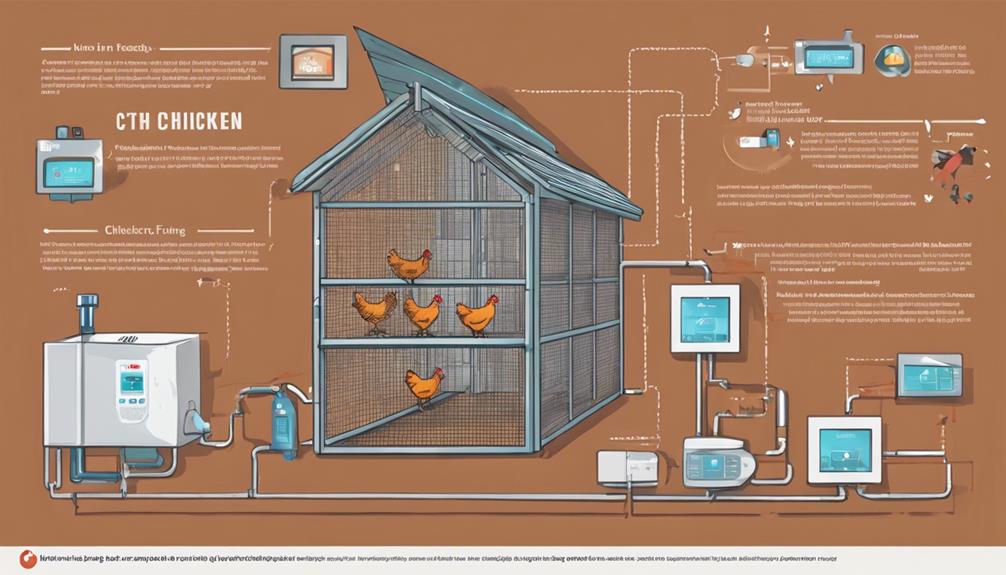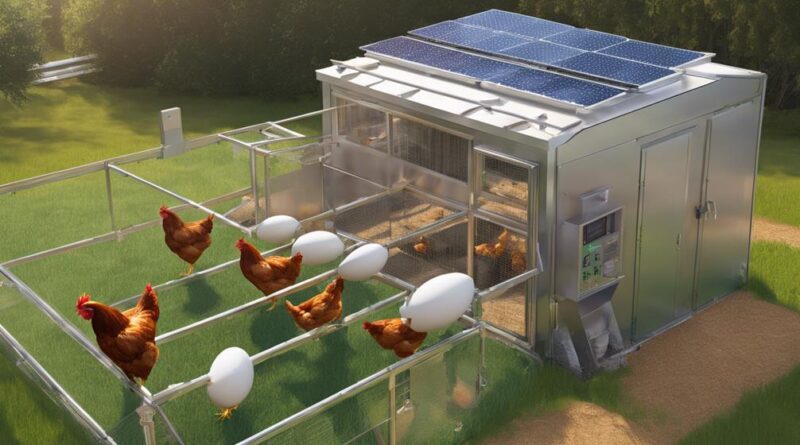Mastering Advanced Tech in Chicken Farming: A Guide"
Upgrade your chicken farm with advanced tech for peak efficiency. Implement automated feeding systems with sensors and software for precise nutrition. Optimize egg collection using robotic collectors and smart sensors. Manage climate for ideal growth and productivity, controlling temperature and humidity. Monitor poultry health with real-time devices for disease prevention and productivity. Improve waste management with closed-loop solutions and biogas production. Enhance chicken growth with energy-efficient LED lighting mimicking natural sunlight. Design smart coops with energy efficiency and remote monitoring capabilities. Utilize data-driven decision-making for proactive flock health measures. Uncover more about mastering advanced tech in chicken farming for optimal results.
Automated Feeding Systems
Automated feeding systems play a crucial role in modern chicken farming, ensuring precise and timely distribution of feed to enhance efficiency and optimize poultry growth. Feeding efficiency is significantly improved through the automation of this process. These systems are designed to deliver the right amount of feed at the right time, preventing wastage and ensuring that chickens receive a consistent and balanced diet. By automating the feeding process, farmers can better control the nutritional intake of their poultry, leading to healthier and more rapidly growing birds.
Technology integration is at the core of automated feeding systems. These systems rely on a combination of sensors, controllers, and software to accurately dispense feed based on specific parameters set by the farmer. Sensors monitor factors such as feed levels, consumption rates, and bird activity to adjust feeding schedules accordingly. The integration of technology allows for real-time monitoring and data analysis, enabling farmers to make informed decisions to optimize feeding practices.
Climate Control Technology
The implementation of advanced climate control technology in chicken farming operations is essential for maintaining optimal environmental conditions to promote poultry health and productivity. Temperature regulation plays a crucial role in ensuring that chickens are comfortable and able to thrive. By utilizing systems such as heaters for cold weather and fans or evaporative cooling for hot climates, farmers can create a consistent temperature range that's ideal for chicken growth. Monitoring and adjusting temperatures based on the age of the chickens is vital, as different stages of growth require specific temperature ranges for optimal development.
Humidity control is another key aspect of climate control technology in chicken farming. High humidity levels can lead to issues such as poor air quality and increased risk of diseases, while low humidity can result in dehydration and stress among the chickens. Implementing systems like humidifiers or ventilation fans can help regulate humidity levels within the chicken coop, ensuring a healthy environment for the poultry.
Incorporating advanced climate control technology not only benefits the chickens but also improves overall farm efficiency and profitability. By maintaining precise temperature and humidity levels, farmers can reduce mortality rates, improve feed conversion ratios, and enhance egg production. Investing in these technologies is a smart choice for modern chicken farmers looking to optimize their operations and ensure the well-being of their livestock.
Egg Collection Innovations
Innovative egg collection methods revolutionize efficiency and precision in modern poultry farming practices. Robotic collectors equipped with advanced sensor technology have transformed the way eggs are gathered on chicken farms. These robotic collectors are programmed to move through the coop, identifying and carefully picking up eggs with gentle precision.
The sensor technology used in these robotic collectors allows them to detect the presence of eggs based on weight, size, and shape. This ensures that only the eggs meeting the desired criteria are collected, reducing the chances of damaged or poor-quality eggs being harvested. The efficiency of these robotic collectors is unparalleled, significantly reducing the labor required for egg collection while also minimizing the risk of human error.
Moreover, the data collected by the sensors during the egg collection process can provide valuable insights to farmers. By analyzing this data, farmers can optimize their production processes, monitor egg-laying patterns, and even detect potential health issues in the flock. This proactive approach to data-driven decision-making can lead to improved overall productivity and welfare of the chickens.
Health Monitoring Devices
Implementing cutting-edge health monitoring devices enhances the welfare and productivity of poultry in modern chicken farming operations. Remote monitoring systems play a crucial role in ensuring the well-being of your flock. These systems allow you to keep track of vital parameters such as temperature, humidity, and air quality in real-time, enabling you to make timely adjustments to create optimal conditions for your chickens.
Moreover, advanced health monitoring devices offer sophisticated disease detection capabilities. By utilizing sensors and AI technology, these devices can detect early signs of illnesses in chickens, allowing you to take proactive measures to prevent the spread of diseases within the flock. Early detection is key to minimizing the impact of diseases on your poultry production.
Additionally, these devices provide valuable data that can be analyzed to identify trends and patterns related to the health of your chickens. By monitoring this data over time, you can gain insights into the overall well-being of your flock and make informed decisions to improve their health and productivity.
Waste Management Solutions
To optimize efficiency and sustainability in chicken farming operations, effective waste management solutions play a critical role. Implementing composting methods and recycling practices can significantly reduce the environmental impact of poultry farming. Composting methods involve the decomposition of organic waste materials to produce nutrient-rich compost that can be used to enhance soil quality and reduce the reliance on artificial fertilizers. By recycling waste such as manure and leftover feed, chicken farmers can create a closed-loop system that minimizes waste production and promotes resource efficiency.
Another innovative waste management solution is biogas production, which involves converting organic waste into biogas through a process called anaerobic digestion. Biogas can be used as a renewable energy source to power farm operations, reducing reliance on fossil fuels and lowering greenhouse gas emissions. Additionally, nutrient recovery from waste streams can help extract valuable nutrients like nitrogen and phosphorus, which can then be reused as fertilizers or soil amendments.
Lighting Systems for Growth
Lighting systems play a crucial role in promoting optimal growth conditions for chickens in modern farming operations. When it comes to enhancing growth and productivity, energy-efficient LED lighting is a game-changer in chicken farming. LED lights consume less energy while providing bright and uniform illumination throughout the coop, mimicking natural sunlight conditions. This not only ensures that chickens have sufficient light for their activities but also helps in maintaining their circadian rhythm, ultimately leading to improved growth rates and overall well-being.
By simulating natural sunlight, LED lighting systems help regulate the chickens' biological processes, such as feeding, egg production, and rest. Natural sunlight simulation provided by LEDs can positively impact the chickens' behavior, leading to reduced stress levels and higher feed conversion rates. Additionally, these systems can be programmed to adjust the light intensity and duration, closely resembling the gradual changes in natural light throughout the day.
Integrating energy-efficient LED lighting that replicates natural sunlight into chicken farming practices is a smart investment. Not only does it contribute to significant energy savings, but it also plays a vital role in promoting the growth and welfare of the chickens. With the right lighting system in place, you can create an environment that supports healthy development and maximizes the potential of your chicken farming operation.
Smart Coop Designs

Smart coop designs revolutionize the efficiency and productivity of modern chicken farming operations through innovative structural and technological advancements. When it comes to energy efficiency, these coops are engineered to optimize energy consumption. They often feature insulated walls and roofs that help regulate internal temperatures, reducing the need for excessive heating or cooling systems. Additionally, smart coops may incorporate solar panels to harness renewable energy for powering lighting, heating, and ventilation systems, further cutting down on electricity costs.
Remote monitoring is another key feature of smart coop designs. By integrating sensors and cameras, farmers can remotely monitor environmental conditions such as temperature, humidity, and air quality. This real-time data allows for prompt adjustments to ensure the well-being of the flock. Moreover, remote monitoring enables farmers to keep track of feed levels, water supply, and even the overall behavior and health of the chickens without having to be physically present at the coop site.
Data-Driven Decision Making
Utilizing data analytics in chicken farming operations enhances decision-making processes by providing actionable insights for optimizing productivity and efficiency. Performance tracking plays a crucial role in this process, allowing farmers to monitor key metrics such as feed consumption, egg production, and growth rates. By collecting and analyzing this data, you can identify trends, patterns, and potential issues that may affect the overall performance of your flock.
Resource optimization is another significant benefit of data-driven decision making in chicken farming. Through detailed analysis of data related to feed usage, water consumption, environmental conditions, and health records, you can make informed decisions to maximize the efficiency of your resources. For example, by tracking feed conversion ratios and correlating them with growth rates, you can adjust feeding schedules to ensure optimal nutrition for your chickens while minimizing waste.
Moreover, data analytics enables you to implement proactive measures to prevent diseases and improve overall flock health. By monitoring health indicators and vaccination schedules, you can identify potential risks early on and take necessary actions to mitigate them. This proactive approach not only enhances the welfare of your chickens but also contributes to the sustainability and profitability of your farming operations. In essence, data-driven decision making empowers you to make informed choices that drive performance and efficiency in your chicken farming venture.
Frequently Asked Questions
How Can I Integrate Different Advanced Tech Systems for Optimal Efficiency?
To integrate different advanced tech systems for optimal efficiency, you need to focus on data analysis and automation integration. By analyzing data from various systems, you can identify areas for improvement.
Automation integration streamlines processes, reducing energy consumption and improving waste management.
Ensuring that these systems work together seamlessly will enhance overall efficiency on your chicken farm.
What Are the Potential Challenges When Implementing Multiple Tech Solutions?
When implementing multiple tech solutions, potential challenges arise. Cost management becomes crucial to avoid overspending.
Training programs must be comprehensive to ensure staff can operate the systems efficiently.
Data security measures are essential to protect sensitive information.
Maintenance schedules need to be established and adhered to meticulously to prevent breakdowns.
Addressing these challenges proactively will help streamline the integration of advanced tech systems on your chicken farm.
Are There Any Compatibility Issues Between Different Tech Solutions?
When implementing multiple tech solutions, compatibility issues can arise due to interoperability concerns and system integration challenges. It's crucial to ensure that different technologies can work together seamlessly to avoid disruptions and optimize efficiency.
How Can I Ensure the Safety and Well-Being of the Chickens With These Technologies?
To ensure the safety and well-being of your chickens with advanced tech, implement biosecurity measures like controlled access and sanitation.
Utilize monitoring systems for real-time surveillance.
Health tracking through wearable sensors and environmental controls such as automated ventilation and lighting will maintain optimal conditions.
Regularly analyze data from these technologies to detect any anomalies early and address them promptly for maximizing chicken welfare and productivity.
Can These Advanced Tech Systems Be Customized to Suit Specific Farm Needs?
When looking at advanced tech systems for your chicken farm, it's essential to consider customization options to meet specific farm requirements.
These systems can often be tailored to suit your needs, whether it's adjusting feeding schedules, monitoring environmental conditions, or automating tasks based on your farm's layout.
Conclusion
In conclusion, mastering advanced technology in chicken farming is essential for maximizing efficiency and productivity. Automated feeding systems, climate control technology, egg collection innovations, health monitoring devices, waste management solutions, lighting systems for growth, smart coop designs, and data-driven decision making are all crucial components for success in the modern poultry industry.
By embracing these advancements, farmers can ensure the health and well-being of their chickens while also optimizing their operations for increased profitability.
